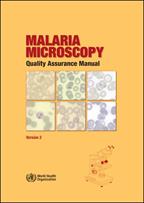Microscopy
WHO recommends prompt parasite-based diagnosis by microscopy or malaria rapid diagnostic test (RDT) in all patients suspected of malaria before antimalarial treatment is administered. Light microscopy entails visualization of the malaria parasites in a blood smear of the patient.
Light microscopy
Malaria microscopy allows the detection of different malaria-causing parasites (P. falciparum, P. vivax, P. malariae, P. ovale and P. knowlesi), their various parasite stages, including gametocytes, and the quantification of parasite density to monitor response to treatment. Microscopy is the method of choice for the investigation of malaria treatment failures. Giemsa is the recommended stain for malaria microscopy, and diagnosis requires examination of both thin and thick films from the same patient. Light microscopy is the diagnostic standard against which other diagnostic methods have traditionally been compared.
Quality assurance of microscopy-based diagnosis
While microscopy remains the mainstay of parasite-based diagnosis in most large health clinics and hospitals, the quality of microscopy-based diagnosis is frequently inadequate for ensuring good sensitivity and specificity of malaria diagnosis, adversely affecting health outcomes and optimal use of resources.An acceptable microscopy service is one that is both cost-effective and provides results that are consistently accurate and sufficiently timely to have a direct impact on treatment. This requires a comprehensive and functioning quality assurance programme.
An effective quality management system for malaria microscopy requires:
- central coordinator(s) to oversee quality assurance;
- a reference (core) group of microscopists at the head, supported by an external quality assurance programme, and with expertise in training and slide validation;
- good training systems in place based on competency relevant to clinical settings;regular retraining and assessment/grading of competency, supported by a validated reference slide set (malaria slide bank);
- a sustainable slide validation system that detects gross inadequacies with good feedback and a system to address inadequate performance;
- good supervision at all levels;
- good supply management and maintenance of microscopes;
- clear standard operating procedures (SOPs) at all levels;
- an adequate budget as part of funding for malaria case management.
Malaria microscopy standard operating procedures
CD-ROM
/pub-covers/cdrom.tmb-144v.jpg?sfvrsn=62681662_2)
Related publications
All →Basic malaria microscopy – Part I: Learner's guide. Second edition
The training manual is divided in two parts: a learner's guide (Part I) and a tutor's guide (Part II). The package includes a CD-ROM, prepared by...
Basic malaria microscopy – Part II: Tutor's guide. Second edition
The training manual is divided in 2 parts: a learner's guide (Part I) and a tutor's guide (Part II). The package includes a CD-ROM, prepared by the...
Bench aids for malaria microscopy
The bench aids for malaria microscopy is a set of 12 plastic laminated A4-size plates produced as aids for the microscopic diagnosis of human...

Malaria microscopy quality assurance manual
Malaria microscopy is one of the methods used to identify malaria-causing parasites (P. falciparum, P. vivax, P. malariae and P. ovale), their various...
This operational manual provides comprehensive guidance to national malaria control programme managers and other stakeholders for rapidly increasing access...
